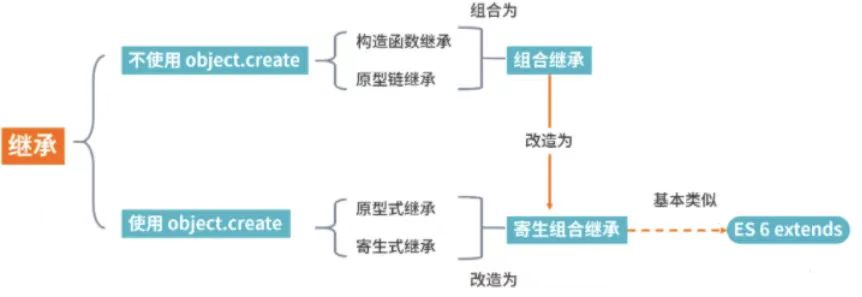JS中实现继承的方式
原型链继承
直接将父类实例赋值给子类的prototype
js
function Parent() {
this.name = 'parent';
this.arr = [1, 2, 3];
}
function Child() {
this.name = 'child';
}
Child.prototype = new Parent();
const child1 = new Child();
const child2 = new Child();
child1.arr.push(4);
// 所有实例共享同一个原型对象
console.log(child1.arr === child2.arr); // true构造函数继承
在子类构造函数中借助call调用Parent构造函数
js
function Parent() {
this.name = 'parent';
this.arr = [1, 2, 3];
}
Parent.prototype.getName = function() {
return this.name;
}
function Child() {
Parent.call(this);
this.name = 'child';
}
const child = new Child();
// 只能继承父类的属性和方法,不能继承父类的原型
console.log(child.arr); // [1, 2, 3]
child.getName(); // Uncaught TypeError: child1.getName is not a function组合继承
结合前面的原型链继承和构造函数继承方式实现
js
function Parent() {
this.name = 'parent';
this.arr = [1, 2, 3];
}
Parent.prototype.getName = function() {
return this.name;
}
function Child() {
// 第二次调用 Parent() 额外开销
Parent.call(this);
this.name = 'child';
}
// 第一次调用 Parent()
Child.prototype = new Parent();
// 手动指向自己的构造函数
Child.prototype.constructor = Child;
const child1 = new Child();
const child2 = new Child();
child1.arr.push(4);
// 互不影响
console.log(child1.arr === child2.arr); // false
// 正常调用
child1.getName(); // child
// 在Child.prototype添加了父类Parent的属性和方法
console.log(child1); // Child {name: 'child', arr: Array(4)}
console.log(Object.getPrototypeOf(child1)); // Parent {name: 'parent', arr: Array(3)}原型式继承
借助Object.create方法实现
js
const parent = {
name:'parent',
arr: [1, 2, 3],
getName: function() {
return this.name;
}
}
// Object.create是浅拷贝
const child1 = Object.create(parent);
child1.name = 'child1';
child1.arr.push(4);
const child2 = Object.create(parent);
child2.name = 'child2';
// 所有实例共享同一个原型对象,存在篡改的可能
console.log(child1.arr === child2.arr); // true
console.log(child1.name === child1.getName()); // true寄生式继承
在前面原型式继承方式上进行优化,利用Object.create添加一些方法进行增强
js
const parent = {
name:'parent',
arr: [1, 2, 3],
getName: function() {
return this.name;
}
}
function clone(original) {
const obj = Object.create(original);
obj.getArr = function() {
return this.arr;
}
return obj;
}
// Object.create是浅拷贝
const child1 = clone(parent);
child1.name = 'child1';
child1.arr.push(4);
const child2 = clone(parent);
child2.name = 'child2';
// 所有实例共享同一个原型对象,存在篡改的可能
console.log(child1.arr === child2.arr); // true
console.log(child1.getArr() === child2.getArr()); // true
console.log(child1.name === child1.getName()); // true
console.log(child1.getArr === child2.getArr); // false寄生组合式继承
基于前面的继承方式进行改造,是所有继承方式里相对最优的继承方式
js
function Parent() {
this.name = 'parent';
this.arr = [1, 2, 3];
}
Parent.prototype.getName = function() {
return this.name;
}
function Child() {
// 将父类的属性和方法添加到子类中
Parent.call(this);
this.name = 'child';
}
// 减少组合继承中多调用一次父类构造函数的问题
Child.prototype = Object.create(Parent.prototype);
Child.prototype.constructor = Child;
Child.prototype.getArr = function() {
return this.arr;
}
const child = new Child();
console.log(child); // Child {name: 'child', arr: Array(3)}
console.log(child.getName()); // child
console.log(child.getArr()); // [1, 2, 3]class继承
通过ES6中class的 extends实现
js
class Parent {
constructor(name) {
this.name = name;
}
// 原型方法
getName() {
console.log('Parent: ', this.name);
return this.name;
}
}
class Child extends Person {
constructor(name, arr) {
// 调用父类构造函数
super(name);
this.arr = arr;
}
getArr() {
return this.arr;
}
}
const child = new Child('child', [1, 2, 3]);总结
